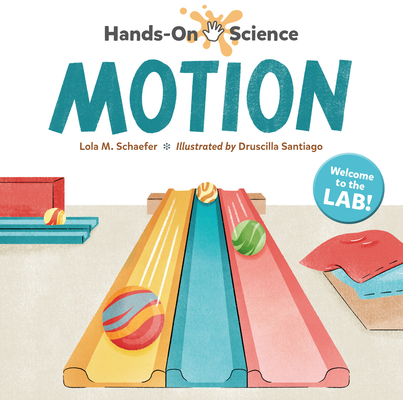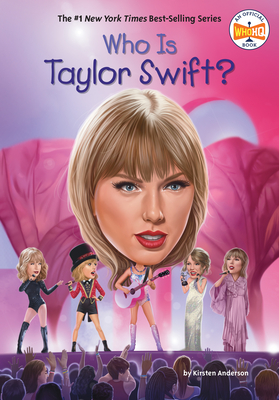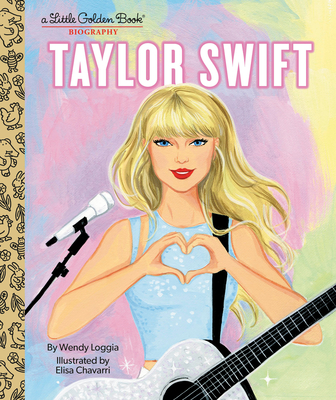
Hands-On Science: Motion
Description
Press Here meets Bill Nye the Science Guy in this interactive STEM picture book about forces and motion.
Welcome to the physics lab! In this picture book, young scientists use their imagination to bring experiements to life. They poke whipped cream in the illustrations, tilt the book to roll a ball down a ramp, and slide beanbags to test friction. After predicting what will happen next, eager readers turn the page to see the results.
Educator and author Lola M. Schaefer draws on her years in the classroom to make science fun and accessible. Back matter encourages kids to notice the pushes and pulls all around them and includes a simple physics experiment.
Praise for Hands-On Science: Motion
A primer on pushes and pulls.
As they did in Matter (2023), Schaefer and Santiago continue to explore basic physics concepts. Their latest is an interactive introduction to force, “a push or pull that can change the motion or shape of an object.” The author explores gravity (simplistically defined as “a force that pulls objects toward Earth”), friction, inertia, and acceleration. But first, she invites readers into the physics lab, where sharp eyes will find the supplies they’ll use in their investigations: whipped cream, sandpaper, a track and marbles, beanbags, a jar of dirt, and even a notebook (a nice touch). As in previous series titles, readers are asked to physically engage with the book. Kids are told to blow on an image of sand, then to touch a button on a lab-vac to clean it up, which leads to an explanation of how a vacuum works. Outside the lab, on a playground, a diverse group of children and adults demonstrate forces at work. (In an online guide for the series, the publisher builds on this idea with a playground-based lesson.) A final, sure-to-please activity asks children to construct a teeter-totter out of a Popsicle stick and a drinking straw, which provides another example of pulls and pushes and gives readers the opportunity to propel a small object into the air. (Be prepared for enthusiastic demonstrations.) The combination of clear, concrete examples, reader interaction, and humor works well.
A child-friendly introduction to a scientific concept.
—Kirkus Reviews
An introduction to the concept of motion through an interactive format that will delight young readers and learners. Following Matter and Geology in the “Hands-On Science” series, this title allows readers to play with the forces of motion without getting messy in a style popularized by Hervé Tullet. The book refers to readers in the second person and informs them that they hold a physics lab in their hands. Physically manipulating the book in different ways (tilting, pressing, etc.) causes elements to shift and change with page turns, introducing the concepts of force, gravity, and friction. The layout of the pages is impeccably uncomplicated and clean, allowing the experiments to take center stage. The lack of unnecessary visual excess and first-person perspective of the illustrations elevates the impression of being able to enact change within the pages. The font is friendly while simple instructional language in short sentences invites early readers to the page. A simple activity on the last page encourages children to notice forces in the real world and provides instruction for a simple craft activity. VERDICT A delightfully interactive introduction to a basic element of physics for the youngest independent readers. Recommended for purchase.
—School Library Journal
Like Hervé Tullet's wildly popular Press Here, the fun, informative, and visually pleasing Hands-On Science series of picture books relies on readers using their imagination to grapple with concepts like geology, matter, and, in this case, motion.
Former classroom teacher Lola M. Schaefer (Lift, Mix, Fling!) is a fan of kids applying their creative faculties to learn about science. In Hands-On Science: Motion, she introduces early physics concepts including force, gravity, and friction through simple experiments. Readers touch illustrations of whipped cream, blow on piles of sand, and tilt the book to make a marble roll down the page. Unlike classic touch-and-feel books like Pat the Bunny, though, the tactile sensations are imagined. ("Sand flew everywhere! What a mess!") Using a mix of playful words ("Bonk!", "Whoosh!") and clear instructions, Schaefer invites readers to interact with the pages. After giving a blob of whipped cream a "poke" and seeing how the force of the finger changes its shape, readers are encouraged to turn the book upside down and shake it: "Uh-oh!... Gravity pulled the cream off the page and onto the floor. Gravity is a force that pulls objects toward Earth."
Hands-On Science series illustrator Druscilla Santiago's uncluttered digital art uses pastel backdrops and plenty of white space to depict items both at rest and interacting with the different forces. Santiago's crisp lines, paired with Schaefer's uncomplicated descriptions, ensure that readers will see how they "create forces every moment of every day.
—Shelf Awareness


